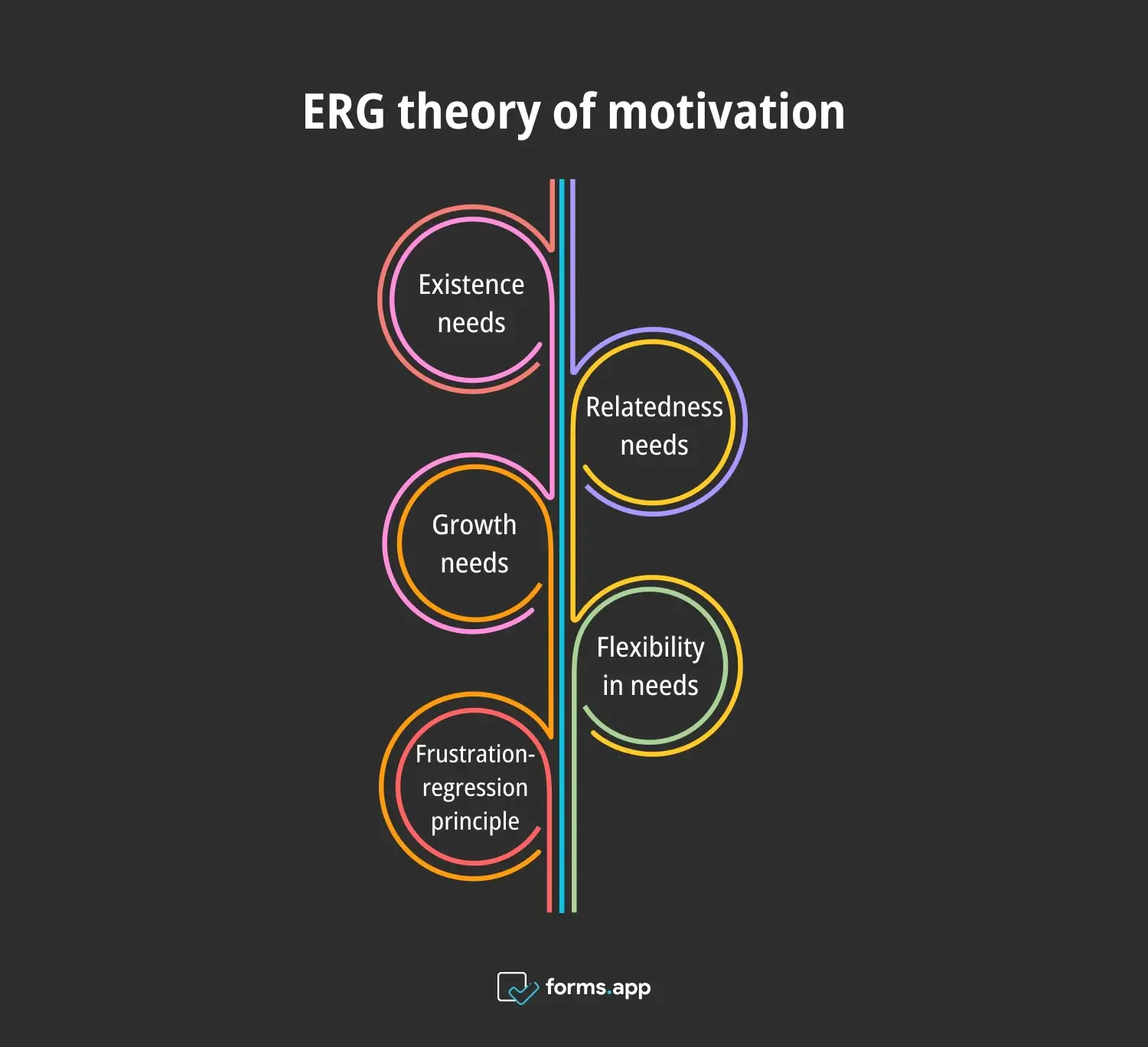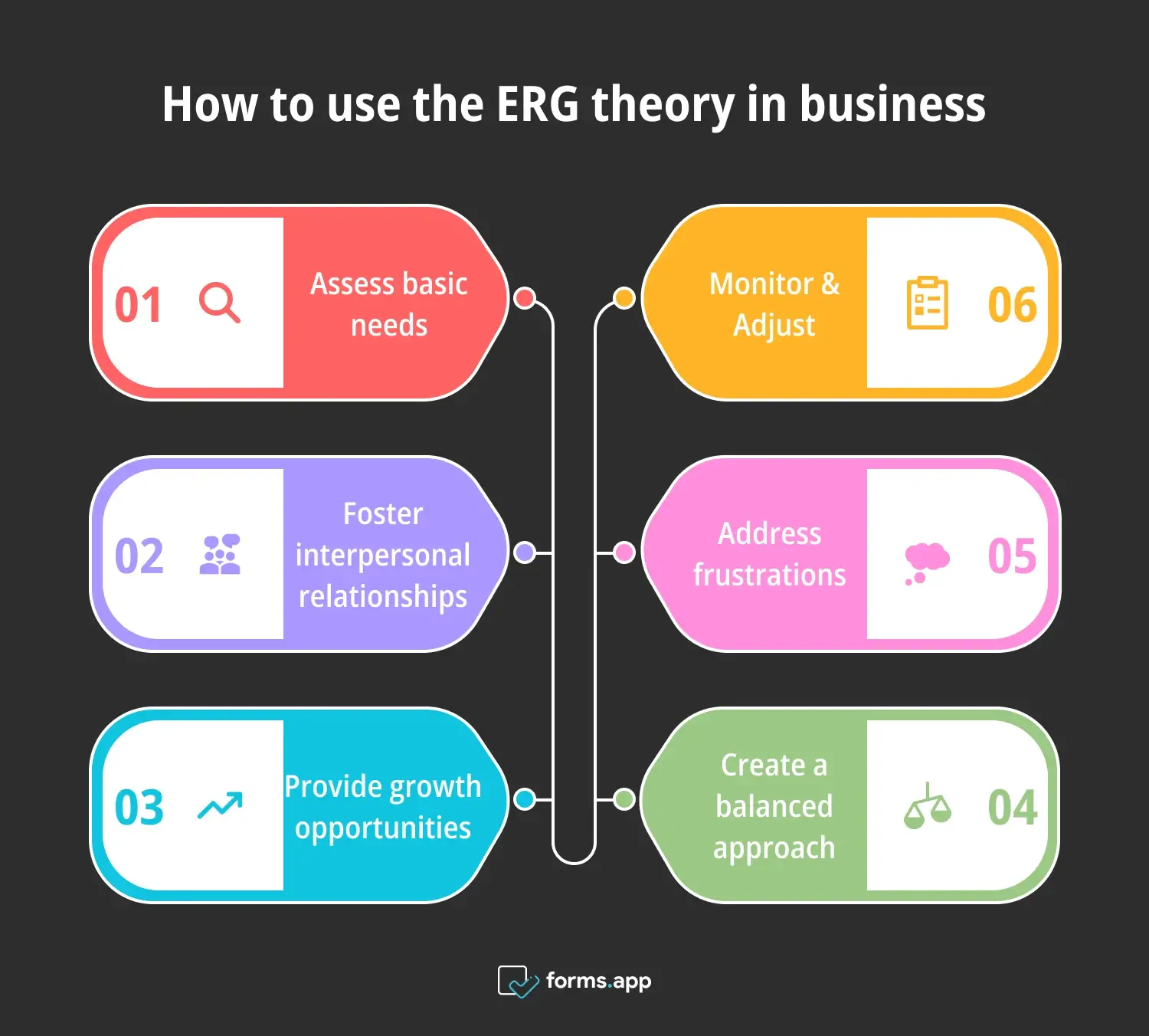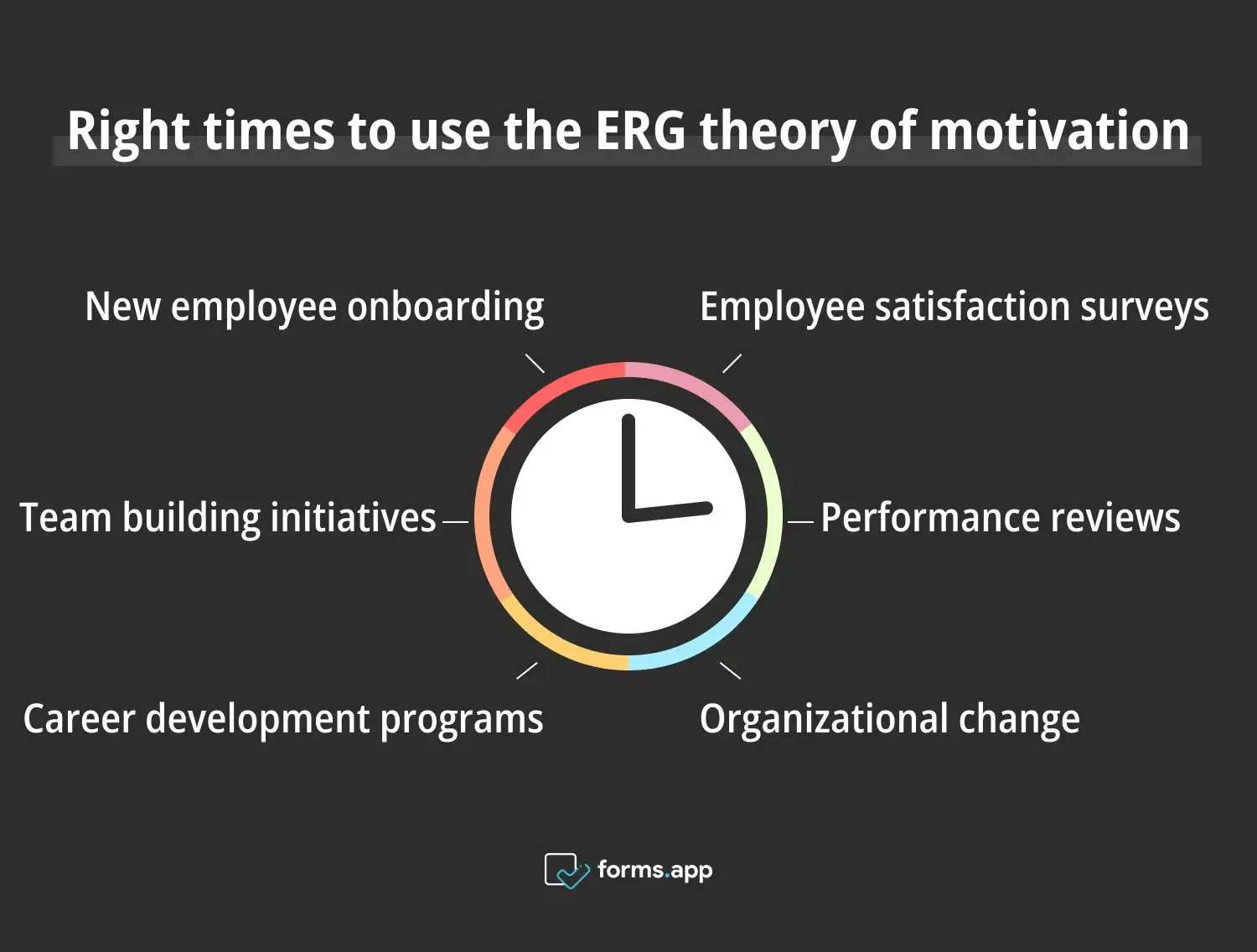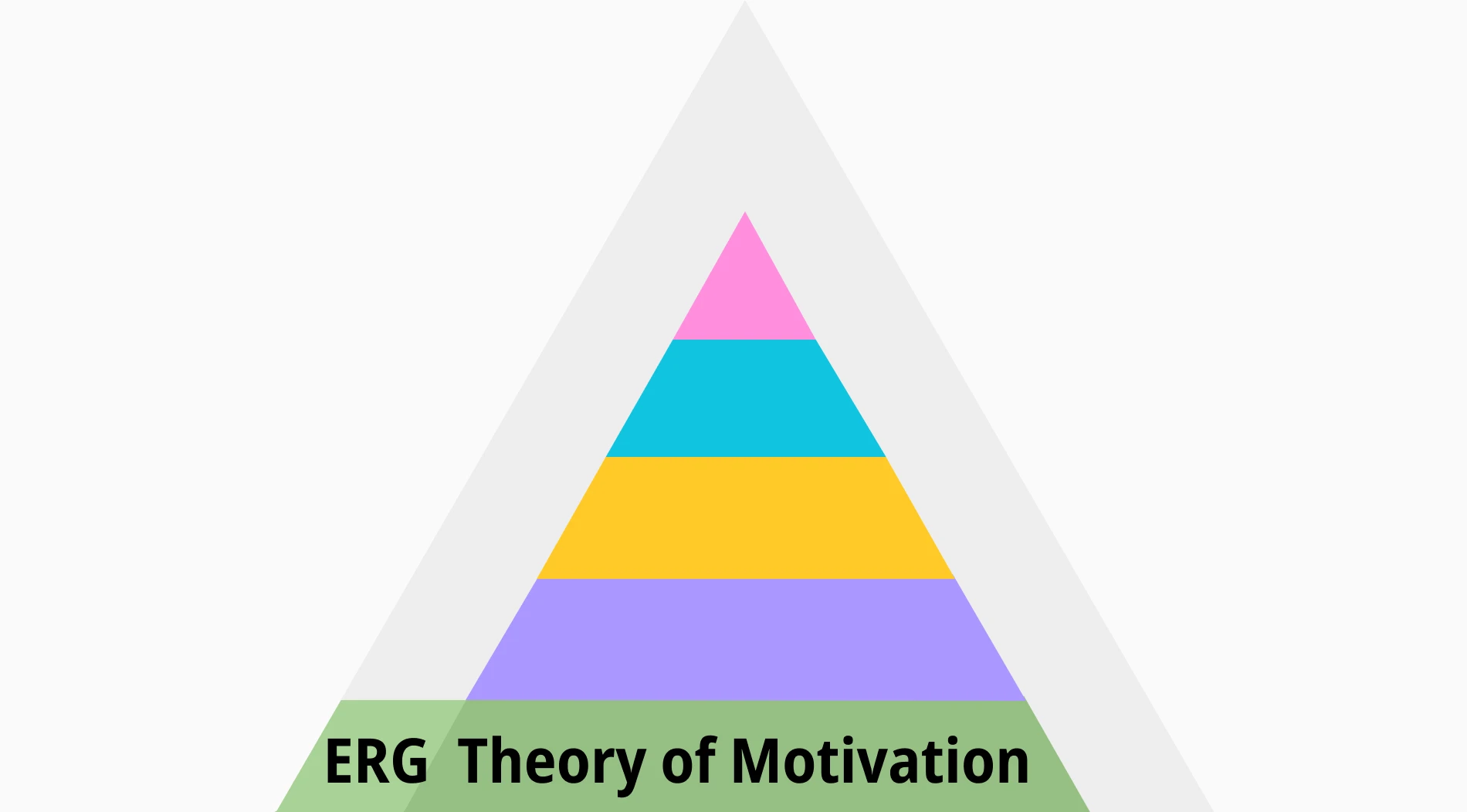Understanding what drives employees is crucial for fostering organizational productivity and job satisfaction. The ERG Theory of Motivation offers a powerful framework for comprehending and effectively addressing these needs, thereby improving employee engagement and performance. By delving into this theory, managers and HR professionals can develop strategies that cater to their fundamental needs.
This article will explore the ERG Theory of Motivation, its definition, components, practical application, advantages, disadvantages, and examples. You will learn how this theory can enhance workplace productivity and employee satisfaction. Additionally, we will discuss a step-by-step guide on implementing the theory and provide answers to FAQs about it.
What is the ERG theory of motivation?
The ERG Theory of Motivation, proposed by Clayton Alderfer, redefines Maslow's Hierarchy of Needs into three core categories: Existence, Relatedness, and Growth.
These categories provide a more flexible approach to understanding human motivation. Simplifying the hierarchy into broader categories makes it easier to apply in various contexts, especially in workplace settings where employee needs are diverse and dynamic.
This theory posits that multiple needs can be pursued simultaneously, and if higher-level needs are unfulfilled, individuals will regress to lower-level needs that appear easier to satisfy. This concept, known as the frustration-regression principle, acknowledges the complexity of human motivation and allows for a more nuanced approach to managing employee needs and expectations.
ERG theory of motivation: Explained
The ERG Theory of motivation, developed by Clayton Alderfer, categorizes human needs into three core groups: Existence, Relatedness, and Growth. This theory builds upon Maslow's hierarchy of needs and translates into different motivating factors in business life. Let's explain the ERG theory of motivation in more detail:

ERG theory of motivation
Existence needs
Existence needs include basic requirements essential for survival, such as food, water, shelter, and safety. This translates to salary, job security, and working conditions in the workplace. Ensuring these fundamental needs are met is the first step in creating a supportive and motivating work environment. Employees who feel secure in their jobs are more likely to be productive.
Relatedness needs
Relatedness needs to involve interpersonal relationships and social interactions. Employees seek meaningful relationships with colleagues and supervisors and a sense of belonging within the organization. Fostering a culture of teamwork, collaboration, and open communication can help meet these needs. Employees who feel connected and valued by their peers are more likely to be motivated and committed to their work.
Growth needs
Growth needs pertain to personal development and self-fulfillment. This includes opportunities for advancement, learning new skills, and achieving one's full potential. Providing employees with opportunities for professional development, such as training programs, workshops, and mentorship, can help satisfy these needs. Employees who see a clear path for growth and advancement are more likely to be motivated.
Flexibility in needs
Unlike Maslow’s rigid hierarchy, ERG Theory suggests that individuals can pursue different needs simultaneously. If growth needs are unmet, an employee might regress to seeking more basic relatedness or existence needs. This flexibility allows for a more realistic understanding of human behavior and motivation, recognizing that individuals may prioritize different needs based on their circumstances at different times.
Frustration-regression principle
The frustration-regression principle posits that when individuals fail to meet higher-order needs, they might regress to lower-order needs that appear more achievable, leading to renewed motivation at a different level. This concept is crucial for managers to understand, as it highlights the importance of addressing all levels of employee needs to prevent frustration and disengagement.
How to use the ERG theory of motivation
Now that we have examined the motivation theory, let's explore its practical application. Here’s a step-by-step guide on how to use the ERG Theory to effectively motivate and manage your team, ensuring their needs are met and productivity is enhanced:

Steps to use the ERG theory in business
Step 1: Assess basic needs
Evaluate if employees' basic existence needs, such as fair wages and safe working conditions, are met. This forms the foundation of employee satisfaction. Conduct regular audits of the workplace environment and compensation packages to ensure they meet industry standards and employee expectations. Address any gaps promptly to prevent dissatisfaction and turnover.
Step 2: Foster interpersonal relationships
Encourage team-building activities and open communication channels to fulfill relatedness needs, creating a supportive and cohesive work environment. Implement regular team meetings, social events, and collaborative projects to foster a sense of community. Ensure that managers and leaders are approachable and supportive, promoting a culture of trust and mutual respect.
Step 3: Provide growth opportunities
Implement training programs, career development plans, and opportunities for advancement to meet growth needs and motivate employees to achieve their full potential. Offer a variety of learning opportunities, such as online courses, workshops, and conferences, to cater to different learning styles. Create clear career paths and provide regular feedback and coaching to help employees achieve their goals.
Step 4: Monitor & Adjust
Regularly assess employee satisfaction through surveys and feedback mechanisms. Adjust strategies as needed to address any emerging unmet needs. Use tools such as employee engagement surveys, one-on-one meetings, and suggestion boxes to gather insights into employee satisfaction. Analyze the data to identify trends and areas for improvement and take action to address any issues.
Step 5: Address frustrations
Be vigilant about signs of frustration or regression. Offer support and resources to help employees overcome barriers to fulfilling their growth needs. Provide access to employee assistance programs, counseling services, and mentorship opportunities. Address any issues promptly and empathetically to prevent frustration from impacting motivation and performance.
Step 6: Create a balanced approach
Strive for a balanced approach that simultaneously addresses existence, relatedness, and growth needs, ensuring overall employee well-being and intrinsic motivation. Develop comprehensive strategies that integrate efforts to meet all needs, and regularly review and adjust these strategies to ensure they remain effective and relevant.
ERG theory of motivation examples
Having explored how to use ERG Theory, let’s examine some example scenarios from different types of companies. These scenarios will illustrate how ERG Theory can be effectively applied in various settings to motivate individuals and address their needs in business life. Let’s take a look at the Alderfer ERG Theory of Motivation examples:
a. Tech company scenario
In a tech company, employees might be motivated by competitive salaries (existence), team collaboration projects (relatedness), and opportunities to work on cutting-edge technologies (growth). By addressing these needs, the company can create an environment that fosters innovation and high performance. For instance, offering competitive compensation packages and organizing regular team-building activities can help meet the diverse needs of tech employees.
b. Healthcare setting
In a hospital, ensuring nurses have adequate rest and safe working conditions (existence), strong support systems and teamwork (relatedness), and continuous professional development opportunities (growth) can enhance motivation. Addressing these needs can help reduce burnout and improve patient care. For example, implementing flexible scheduling and offering ongoing training and career advancement opportunities can help meet the needs of healthcare professionals.
c. Educational institution
Teachers in a school might need competitive pay (existence), a supportive community (relatedness), and opportunities for professional growth and innovation in teaching methods (growth) to stay motivated. By addressing these needs, schools can enhance teacher retention and student outcomes. For instance, providing competitive salaries and fostering a positive and collaborative school culture can help meet the needs of educators.
Pros & cons of the ERG theory of motivation
After looking at examples of ERG Theory in business life, it's essential to understand its strengths and weaknesses. Let's delve into the advantages and disadvantages of ERG Theory to appreciate better its application and limitations in different contexts of organizations.
Advantages
➕Flexibility: Allows for simultaneous pursuit of different needs, making it more adaptable to individual circumstances. This flexibility makes the ERG Theory more applicable in real-world settings where employees have diverse and changing needs.
➕Practicality: More reflective of real-life experiences where needs do not follow a strict hierarchy. By recognizing that individuals may prioritize different needs at different times, ERG Theory provides a more realistic and practical framework for understanding motivation.
➕Motivation insight: Provides deeper insight into the multifaceted nature of employee motivation. By simultaneously considering multiple levels of needs, managers can develop more comprehensive and effective strategies to motivate their employees.
➕Application in various sectors: The theory can be applied across various industries and job roles. Whether in healthcare, education, technology, or any other sector, the principles of ERG Theory can be adapted to meet employees' specific needs.
➕Improved employee satisfaction: By addressing multiple needs, overall employee satisfaction and productivity can be enhanced. A holistic approach to meeting employee needs can lead to higher engagement, performance, and retention levels.
Disadvantages
➖Complexity: More complex to implement compared to simpler models like Abraham Maslow’s hierarchy. The need to address multiple levels of needs simultaneously can make the implementation of ERG Theory more challenging and resource-intensive.
➖Resource intensive: Requires ongoing assessment and adjustment, which can be resource-intensive. Regularly evaluating and addressing employee needs can require significant time and effort from managers and HR professionals.
➖Potential for misinterpretation: Misunderstanding the regression aspect can lead to incorrect application of the theory. Without a clear understanding of the frustration-regression principle, managers may fail to effectively address employee needs and prevent regression.
When to use the ERG theory of motivation
Understanding the advantages and disadvantages of ERG Theory helps in knowing its practical value in business. Now, let's explore when it's most effective to use ERG Theory. We'll identify specific situations where applying this theory can significantly enhance motivation and productivity.

Correct times to use the ERG theory of motivation
⏰New employee onboarding: Assess and address new hires' existence, relatedness, and growth needs to ensure smooth integration. Understanding and meeting the needs of new employees can help them feel welcomed and supported, leading to higher engagement and retention.
⏰Team building initiatives: Foster a sense of belonging and camaraderie to meet relatedness needs. Implementing team-building activities and promoting a collaborative work environment can help employees feel connected and valued, enhancing motivation and performance.
⏰Career development programs: Provide growth opportunities to retain and motivate employees. Offering professional development opportunities, clear career paths, and regular feedback can help employees achieve their goals and stay motivated.
⏰Employee satisfaction surveys: Use surveys to identify unmet needs and address them accordingly. Regularly assessing employee satisfaction and taking action to address any issues can help maintain high levels of motivation and engagement.
⏰Performance reviews: Incorporate ERG principles to understand motivational issues and plan for development. Using ERG Theory to guide performance reviews can help managers identify and address the specific needs of their employees, leading to improved performance and satisfaction.
⏰Organizational change: During change periods, ensure all needs are addressed to maintain motivation. By understanding and addressing the diverse needs of employees during times of change, organizations can help maintain motivation and prevent disengagement.
Maslow’s hierarchy of needs vs. ERG theory of motivation
Understanding the differences between Maslow’s hierarchy of needs and the ERG Theory of motivation is crucial for effectively addressing human motivation. While both theories aim to explain how individuals satisfy their needs, they differ significantly in structure, flexibility, and application.
This comparison highlights key distinctions and practical implications, helping you choose the most appropriate framework for various motivational contexts:

Comparison between Maslow’s hierarchy of needs and ERG theory of motivation
Structure & Flexibility
Maslow's hierarchy of needs is organized as a five-level pyramid, with individuals moving from basic physiological needs to self-actualization in a fixed sequence. In contrast, ERG Theory simplifies these into three categories—Existence, Relatedness, and Growth—allowing for more flexible movement between them. This structure acknowledges that human motivation is not strictly linear, permitting individuals to pursue various needs concurrently, depending on personal circumstances and priorities.
Simultaneous needs fulfillment
Maslow's theory posits that individuals must satisfy lower-level needs before advancing to higher-level ones, creating a sequential path. ERG Theory, however, recognizes that different needs can be pursued simultaneously. For instance, one might seek personal growth while maintaining strong social relationships. This approach mirrors real-life scenarios where multiple needs are addressed simultaneously, providing a more realistic understanding of human motivation.
Frustration-regression principle
ERG Theory introduces the frustration-regression principle, which suggests that when individuals cannot meet higher-level needs, they may revert to fulfilling lower-level needs. This is a key difference from Maslow's theory, where unmet higher needs do not cause regression but halt progression. ERG Theory’s principle provides a more dynamic and adaptable framework, reflecting the complex nature of human motivation and the impacts of unmet needs.
Practical application
In practical terms, ERG Theory offers a more adaptable approach to motivation in various settings, such as workplaces and educational environments. Unlike Maslow's rigid hierarchy, ERG Theory’s flexibility allows managers and educators to address multiple needs simultaneously, enhancing motivation and productivity. By understanding that needs can overlap and change, organizations can create more effective strategies to meet the diverse motivations of individuals.
Frequently asked questions about the ERG theory of motivation
You might have some lingering questions after discussing when to use ERG Theory. In this section, we'll address some of the most frequently asked questions to clarify any doubts and provide further insights into the practical application of ERG Theory.
The three elements of ERG Theory are Existence, Relatedness, and Growth. Existence addresses basic material needs, Relatedness focuses on interpersonal relationships, and Growth involves personal development and self-fulfillment. These categories help understand and address different aspects of motivation within an individual.
The primary difference between Maslow's hierarchy of needs and ERG Theory is structure and flexibility. Maslow's theory is a five-tier pyramid with a rigid progression. In contrast, ERG Theory condenses the needs into three categories and allows for more fluid movement between them, acknowledging that multiple needs can be pursued simultaneously.
The ERG Theory of motivation was developed in 1969 by Clayton Alderfer. It aimed to address some of the limitations of Maslow's hierarchy of needs by providing a more flexible and simplified approach to understanding human motivation, considering human needs' overlapping and dynamic nature.
Clayton Alderfer, an American psychologist, invented the ERG Theory of motivation. His work built on Maslow's hierarchy of needs, seeking to refine and expand upon it to reflect the complexity of human motivation better and provide a more practical framework for understanding and addressing individual needs.
Conclusion
The ERG Theory of Motivation is a powerful tool for understanding and enhancing employee motivation by addressing their existence, relatedness, and growth needs. By applying this theory, organizations can create a more supportive and motivating work environment, increasing productivity and satisfaction.
This article explored the ERG Theory of Motivation, its components, applications, and benefits. Apply this theory to foster a motivated and productive workforce, ensuring employees' existence, relatedness, and growth needs are met. By doing so, you can enhance overall organizational performance and employee well-being.
Fatih is a content writer at forms.app and a translator specializing in many text domains, including medical, legal, and technical. He loves studying foreign languages. Fatih especially likes to create content about program management, organizational models, and planning tools.
- What is the ERG theory of motivation?
- ERG theory of motivation: Explained
- How to use the ERG theory of motivation
- ERG theory of motivation examples
- Pros & cons of the ERG theory of motivation
- When to use the ERG theory of motivation
- Maslow’s hierarchy of needs vs. ERG theory of motivation
- Frequently asked questions about the ERG theory of motivation
- Conclusion



